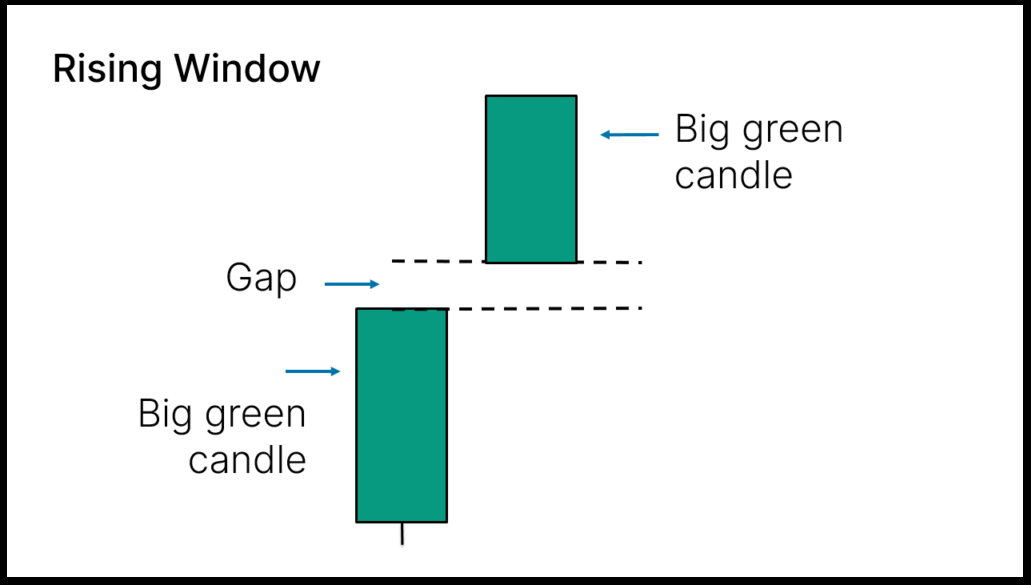Rising Window Candlestick Pattern: A Comprehensive Guide
Introduction
The Rising Window, also known as a bullish gap, is a candlestick pattern used in technical analysis to predict future price movements. This pattern indicates a continuation of a bullish trend and is characterized by a gap between two candlesticks. Understanding and identifying the Rising Window pattern can help traders make informed decisions about entering or exiting positions. This article will explore the formation, characteristics, interpretation, and practical trading strategies associated with the Rising Window candlestick pattern.

Understanding the Rising Window Pattern
The Rising Window pattern occurs when there is a significant gap between two candlesticks, indicating strong buying momentum and a continuation of the upward trend. The gap, or “window,” is created when the second candlestick opens higher than the high of the previous candlestick, and the gap does not get filled during the trading session.
Formation and Characteristics
The Rising Window pattern consists of two candlesticks and is characterized by the following elements:
- First Candlestick: This is a bullish candlestick that continues the prevailing uptrend. It indicates strong buying pressure.
- Second Candlestick: This is another bullish candlestick that opens above the high of the first candlestick, creating a gap. The gap should remain unfilled during the trading session, demonstrating sustained buying interest.
Interpreting the Rising Window Pattern
The Rising Window pattern provides insights into market psychology and potential future price movements:
- Continuation Signal: The pattern signals the continuation of the existing uptrend, helping traders align their strategies with the prevailing market direction.
- Market Psychology: The gap between the two candlesticks indicates a surge in buying interest and a lack of selling pressure. This shows that buyers are willing to pay higher prices, reinforcing the bullish sentiment.
- Strength of Trend: The size of the gap and the ability of the second candlestick to maintain the gap without filling it suggests strong bullish momentum and the likelihood of continued upward movement.
Practical Trading Strategies
Traders can use the Rising Window pattern to develop effective trading strategies. Here are some practical approaches:
- Entering Long Positions: Traders can enter long positions after the formation of the second candlestick, anticipating the continuation of the uptrend. The unfilled gap serves as a confirmation of bullish momentum.
- Example: If a stock shows a Rising Window pattern, a trader might enter a long position on the day following the formation of the second candlestick, expecting the uptrend to continue.
- Stop-Loss Placement: To manage risk, traders can place stop-loss orders below the gap. This helps protect against potential trend reversals.
- Example: For a Rising Window pattern, the stop-loss order can be placed below the low of the first candlestick to limit potential losses if the trend fails to continue.
- Confirmation with Other Indicators: To reduce the risk of false signals, traders often seek additional confirmation from other technical indicators, such as moving averages, relative strength index (RSI), or volume analysis.
- Example: Before entering a long position based on the Rising Window pattern, a trader might check if the RSI is above 50, indicating bullish momentum, or if the volume during the formation of the pattern is higher than average, confirming strong buying pressure.
Example of Rising Window Pattern in Action
Imagine a stock that has been in a steady uptrend. On Day 1, it forms a bullish candlestick. On Day 2, the stock opens significantly higher than the high of Day 1, creating a gap. It then continues to move higher throughout the trading session, forming another bullish candlestick and maintaining the gap. This sequence forms a Rising Window pattern, signaling the likely continuation of the uptrend.
Limitations and Considerations
While the Rising Window pattern is a useful continuation pattern, it is essential to consider its limitations:
- Market Conditions: The pattern is most reliable in trending markets. In choppy or sideways markets, its predictive power may be reduced.
- Gap Size: The size of the gap can influence the pattern’s reliability. Larger gaps generally indicate stronger bullish momentum, while smaller gaps may be less significant.
- Confirmation Needed: Relying solely on the Rising Window pattern without additional confirmation from other indicators or patterns can lead to false signals.
- Time Frame: The pattern’s reliability may vary across different time frames. Traders should consider the context of the overall trend and the specific time frame they are trading.
Conclusion
The Rising Window candlestick pattern is a valuable tool for traders looking to capitalize on continued bullish momentum in the market. By understanding its formation, interpretation, and significance, traders can enhance their technical analysis toolkit and make more informed trading decisions. As with all technical analysis tools, it is essential to use the Rising Window pattern in conjunction with other indicators and analysis techniques to increase the reliability of trading signals and manage risks effectively.
By mastering the Rising Window pattern, traders can better navigate the complexities of financial markets and improve their chances of achieving consistent success.

EDUBRUG is a top educational institute known for offering the best stock market courses in India. Our goal is to make financial markets easy to understand and help people learn about trading. Eduburg has quickly become a popular choice for those who want to become successful traders and investors. Our experienced faculties, who are certified, provide practical training in stock trading, technical analysis, and financial planning. Eduburg is dedicated to providing high-quality education, ensuring that our students gain the skills and confidence needed to succeed in the stock market.